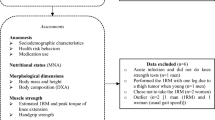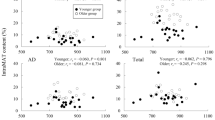Abstract
OBJECTIVE: To investigate whether peripheral muscle strength is significantly different between lean and obese women controlled for age and physical activity, using an allometric approach.
DESIGN: Cross-sectional study of isometric handgrip and isokinetic leg and trunk muscle strength.
SUBJECTS: 173 obese (age 39.9±11.4 y, body mass index (BMI) 37.8±5.3 kg/m2) and 80 lean (age 39.7±12.2 y, BMI 22.0±2.2 kg/m2) women.
MEASUREMENTS: Anthropometric measures (weight, height) and body composition (bioelectrical impedance method), isometric handgrip (maximal voluntary contraction on the Jamar dynamometer), isokinetic trunk flexion–extension, trunk rotation, and knee flexion–extension (Cybex dynamometers).
RESULTS: Absolute isokinetic strength output (that is, strength uncorrected for fat-free mass) was larger in obese compared to lean women, except for knee flexion and isometric handgrip, which were not significantly different (P>0.05). Pearson correlation coefficients between strength measures and fat-free mass (kg) were low to moderate both in lean (r=0.28–0.53, P<0.05) and in obese (r=0.29–0.49, P<0.001) women. There was no correlation with fat mass (kg) in the lean, whereas in the obese women a weak positive relation could be observed for most isokinetic data (r=0.21–0.39, P<0.01). When correcting for fat-free mass (raised to the optimal exponent determined by allometric scaling), all strength measurements were at least 6% lower in obese when compared to the lean women, except for trunk flexion, which was at least 8% stronger in obese women.
DISCUSSION: The higher absolute knee extension strength measures of leg and the similar extension strength of the trunk in the obese sample compared to the lean might be explained by the training effect of weight bearing and support of a larger body mass. However when the independent effect of fat-free mass is removed, these strength measures, as well as oblique abdominal muscle and handgrip strength, turned out to be lower in obese women. These observations could be the reflection of the overall impairment of physical fitness as a consequence of obesity and its metabolic complications.
This is a preview of subscription content, access via your institution
Access options
Subscribe to this journal
Receive 12 print issues and online access
$259.00 per year
only $21.58 per issue
Buy this article
- Purchase on Springer Link
- Instant access to full article PDF
Prices may be subject to local taxes which are calculated during checkout
Similar content being viewed by others
References
Bouchard C, Shepard RJ . Physical activity, fitness and health: the model and key concepts. Human Kinetic Publishers: Champaign 1994 77–88.
Hulens M, Vansant G, Lysens R, Claessens ALM, Muls E . The assessment of peripheral isokinetic muscle strength in obese and morbidly obese women J Orthop Sports Phys Ther (submitted)
Vague J . Obesities. John Libby and Co Ltd.: Marseille 1991.
Delitto A, Crandell CE, Rose SJ . Peak torque-to-body weight ratios in the trunk: a critical analysis Phys Ther 1989 69: 138–143.
Neder JA, Nery LE, Shinzato GT, Andrade MS, Peres C, Silva, AC . Reference values for concentric knee isokinetic strength and power in non-athletic men and women from 20 to 80 years old J Orthop Sports Phys Ther 1999 29: 116–126.
Frontera WR, Hughes VA, Lutz KJ, Evans WJ. A cross-sectional study of muscle strength and mass in 45- to 78-year-old men and women . J Appl Phys 1991 71: 644–650.
Payette H, Hanusaik N, Boutier V, Morais JA, Gray-Donald, K . Muscle strength and functional mobility in relation to lean body mass in free-living frail elderly women Eur J Clin Nutr 1998 52: 45–53.
Madsen OR, Brot C, Petersen MM, Sorensen OH . Body composition and muscle strength in women scheduled for a knee or hip replacement. A comparative study of 2 groups of osteoarthritic women Clin Reumatol 1997 16: 39–44.
Pi-Sunyer FX . Comorbidities of overweight and obesity: current evidence and research issues Med Sci Sports Exerc 1999 31 (Suppl 11): S602–S608.
Slemenda C, Heilman DK, Brandt KD, Katz BP, Mazzuca SA, Braunstein EM, Byrd D . Reduced quadriceps strength relative to body weight: a risk for knee osteoarthritis in women? Arthritis Rheum 1998 41: 1951–1959.
Wessel J . Isometric strength measurements of knee extensors in women with osteoarthritis of the knee J Rheumatol 1996 23: 328–331.
Lee JH, Hoshino Y, Nakmura K, Kariya I, Sata K, Ito K . Trunk muscle weakness as a risk factor for low back pain. A 5-year prospective study Spine 1999 24: 54–57.
Jebb SA, Moore MS . Contribution of a sedentary lifestyle and inactivity to the etiology of overweight and obesity: current evidence and research issues Med Sci Sports Exerc 1999 31 (Suppl 11): S534–S541.
Jurimae T, Jurimae J . Anthropometric and health-related fitness characteristics in middle-aged obese women Coll Antropol 1998 22: 97–106.
Cauley JA, Petrini AM . The decline of grip strength in the menopause: relationship to physical activity, estrogen use and anthropometric factors J Chron Dis 1997 40: 115–120.
Nevill AM, Holder RL . Scaling, normalizing, and per ratio standards: an allometric modeling approach J Appl Phys 1995 79: 1027–1031.
Nevill AM, Ramsbottom R, Williams C . Scaling physiological measurements for subjects of different body size Eur J Appl Physiol 1992 65: 110–117.
Vanderburgh PM, Kusano M, Sharp M, Nindl B . Gender differences in muscular strength: an allometric model approach Biomed Sci Instrum 1997 33: 100–105.
Vanderburgh PM, Dooman C . Considering body mass differences, who are the world's strongest women? Med Sci Sports Exerc 2000 32: 197–201.
Davies MJ, Dalsky GP . Normalizing strength for body size differences in older adults Med Sci Sports Exerc 1997 29: 713–717.
Hurley BF . Age, gender, and muscular strength J Gerontol A Biol Sci Med Sci 1995 50 (Spec. No): 41–44.
Jerome JA, Hunter K, Gordon P, McKay N . A new robust index for measuring isokinetic trunk flexion and extension. Outcome from a regional study Spine 1991 16: 804–808.
Baecke, JAH, Burema J, Frijters JER . A short questionnaire for the assessment of habitual physical activity in epidemiological studies Am J Clin Nutr 1982 36: 936–942.
Baumgartner RN, Ross R, Heymsfield SB . Does adipose tissue influence bioelectric impedance in obese men and women? J Appl Physiol 1999 84: 257–262.
Stanley BG, Tribuzi SM . Concepts in hand rehabilitation. FA Davis Company: Philadelphia 1992 p 548.
Wessel J, Ford D, vanDriesum D . Measurement of torque of trunk flexors at different velocities Scand J Rehabil Med 1999 24: 175–180.
Diffrient N, Tilley, AR, Bardagiy JC . Humanscale 1/2/3. MIT Press: Cambridge, Massachusetts 1978.
Dvir Z . Isokinetics. Longman Publishers: Singapore; 1995.
Madsen OR . Trunk extensor and flexor strength measured by the Cybex 6000 dynamometer. Assessment of short-term and long-term reproducibility of several strength variables Spine 1996 21: 2770–2776.
Matheson L, Mooney V, Caiozzo V, Jarvis G, Pottinger J, DeBerry C, Backlund K, Klein K, Antoni J . Effect of instructions on isokinetic trunk strength testing variability, reliability, absolute value, and predictive validity Spine 1992 17: 914–921.
Shepard RJ, Montelpare W, Plyley M, McCracken D, Goode RC . Handgrip dynamometry, cybex measurements and lean mass as markers of the aging of the muscle function Br J Sports Med 1991 25: 204–208.
Bohannon RW . Hand-grip dynamometry provides a valid indication of upper extremity strength impairment in home care patients J Hand Ther 1998 11: 258–260.
Author information
Authors and Affiliations
Corresponding author
Rights and permissions
About this article
Cite this article
Hulens, M., Vansant, G., Lysens, R. et al. Study of differences in peripheral muscle strength of lean versus obese women: an allometric approach. Int J Obes 25, 676–681 (2001). https://doi.org/10.1038/sj.ijo.0801560
Received:
Revised:
Accepted:
Published:
Issue Date:
DOI: https://doi.org/10.1038/sj.ijo.0801560
Keywords
This article is cited by
-
Associations between grip strength, cardiorespiratory fitness, cardiovascular risk and mental health in forcibly displaced people from a Greek refugee camp
Scientific Reports (2023)
-
Causal associations between cardiorespiratory fitness and type 2 diabetes
Nature Communications (2023)
-
Handgrip strength adjusted for body mass and stratified by age and sex: normative data for healthy Brazilian adults based on a systematic review
Sport Sciences for Health (2022)
-
Knee flexor and extensor torque ratio in elderly men and women with and without obesity: a cross-sectional study
Aging Clinical and Experimental Research (2022)
-
The association between low lean mass and osteoporosis increases the risk of weakness, poor physical performance and frailty in Brazilian older adults: data from SARCOS study
European Journal of Clinical Nutrition (2021)



